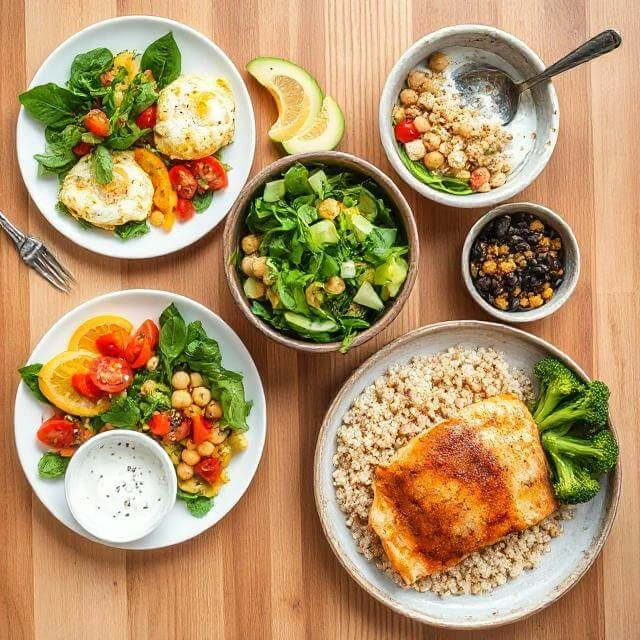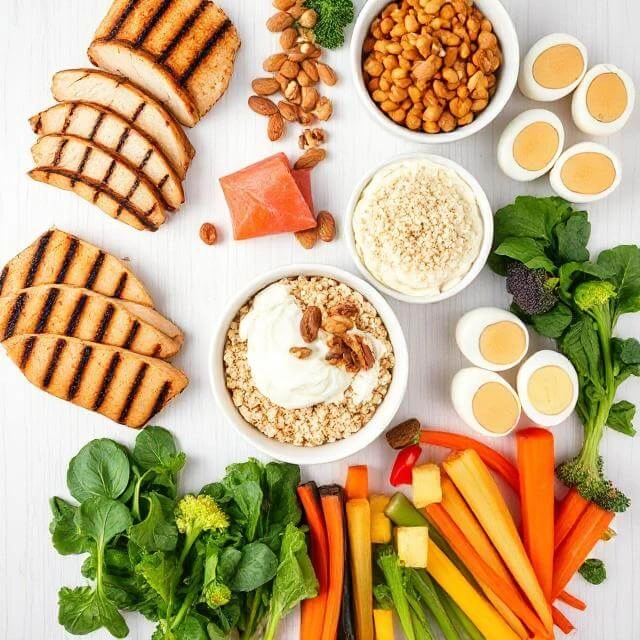Introduction
Best protein rich foods for diabetes : When managing diabetes, most people focus solely on cutting sugar and carbohydrates—but there’s another key player in a healthy diabetic diet: protein.
Protein does much more than build muscle. For people with diabetes, it plays a crucial role in balancing blood sugar levels, controlling hunger, and supporting long-term metabolic health. Unlike carbs, protein doesn’t cause sharp spikes in blood glucose, making it a valuable ally in diabetes management.
Including the right amount of high-quality protein in every meal can help you feel full longer, reduce the urge to snack on sugary foods, and maintain lean body mass—which is especially important if you’re working on weight loss or staying active.
In this article, we’ll explore the best protein-rich foods that are both nutritious and diabetes-friendly, and how to add them to your daily routine with confidence.
Why Protein Is Important for People with Diabetes
Protein plays a vital role in the daily management of diabetes—and not just because it helps build strong muscles. It directly impacts blood sugar control, hunger levels, and overall health, making it an essential part of any diabetes-friendly eating plan.
1. Slows Down Digestion and Prevents Blood Sugar Spikes
Unlike carbohydrates, protein takes longer to digest. This slower digestion process helps stabilize blood sugar levels by preventing rapid spikes and crashes after meals. When paired with complex carbs and healthy fats, protein creates a more gradual and steady release of glucose into the bloodstream.
2. Helps with Weight Management and Energy Balance
Managing a healthy weight is especially important for people with Type 2 diabetes. Protein keeps you feeling full and satisfied, which can naturally reduce cravings and prevent overeating. It also helps maintain your energy levels throughout the day, reducing the chances of blood sugar dips that leave you feeling tired or sluggish.
3. Supports Muscle Health, Especially in Older Adults
As we age, maintaining lean muscle mass becomes more challenging—yet it’s essential for metabolic health. For people with diabetes, muscle tissue plays a key role in regulating blood sugar. Consuming enough protein helps preserve muscle strength, supports mobility, and improves insulin sensitivity—especially important for older adults managing Type 2 diabetes.
How Much Protein Do You Need?
The ideal amount of protein can vary from person to person, but for most people with diabetes, a moderate and consistent intake throughout the day can support better blood sugar control and overall health.
General Recommendations
Most health experts recommend:
- 0.8 to 1.0 grams of protein per kilogram of body weight per day for adults with diabetes.
- For example, a person weighing 70 kg (about 154 lbs) would need around 56–70 grams of protein daily.
However, these are general guidelines. It’s essential to consult with your doctor or registered dietitian to determine the right amount for your specific needs and health goals.
Factors That Affect Your Protein Needs
Several factors influence how much protein you should consume, including:
Health Goals: Whether you’re trying to lose weight, build muscle, or manage other conditions (like high cholesterol), your protein needs can change.
Age: Older adults may need slightly more protein to maintain muscle mass and prevent age-related muscle loss (sarcopenia).
Activity Level: People who are physically active or trying to build or maintain muscle may require more protein.
Type and Stage of Diabetes: Needs may differ slightly between those with Type 1, Type 2, or gestational diabetes. Individuals with kidney complications related to diabetes may need to monitor protein intake more carefully.
Best Protein-Rich Foods for Diabetes

When choosing protein sources for a diabetes-friendly diet, it’s important to focus on foods that are nutrient-dense, low in unhealthy fats, and gentle on blood sugar levels. Below are some of the best options from both animal and plant sources.
A. Animal-Based Protein Sources
These options are naturally low in carbohydrates and provide complete proteins, meaning they contain all nine essential amino acids your body needs:
- Eggs
A powerhouse of high-quality protein and virtually no carbs. Eggs make an excellent, budget-friendly breakfast option and help you stay full for hours. - Chicken & Turkey (Skinless)
Lean, versatile, and low in saturated fat when skinless. Perfect for grilling, baking, or adding to salads and stews. - Fish (Especially Salmon, Sardines, Mackerel)
Rich in omega-3 fatty acids, which support heart health, and packed with protein. Great for people with diabetes who also need to manage cholesterol. - Greek Yogurt (Unsweetened)
Higher in protein than regular yogurt and also supports gut health. Choose plain, unsweetened varieties to avoid added sugars. - Cottage Cheese
A low-carb dairy option that’s rich in calcium and protein. Ideal as a snack or breakfast ingredient. - Lean Beef or Pork
Choose lean cuts like sirloin, tenderloin, or pork loin to reduce saturated fat intake. These meats provide iron, zinc, and essential nutrients.
B. Plant-Based Protein Sources
Plant proteins offer additional benefits like fiber, antioxidants, and healthy fats, making them excellent choices for diabetes management:
- Lentils
High in protein and soluble fiber, which helps slow digestion and stabilize blood sugar. Great in soups, salads, or stews. - Chickpeas & Other Beans
Offer a good balance of carbs and protein. Their fiber content helps regulate blood sugar and improve digestive health. - Tofu & Tempeh
Plant-based, low-carb, and complete proteins made from soybeans. They’re great meat alternatives and absorb flavors well in stir-fries and curries. - Quinoa
A gluten-free whole grain that provides all essential amino acids. Excellent as a base for grain bowls or salads. - Nuts & Seeds (Almonds, Chia, Flax)
Rich in healthy fats, protein, and fiber. They help reduce inflammation and support heart health—just watch portion sizes to avoid excess calories.
Including a variety of both animal and plant-based proteins can keep meals interesting, nutritionally balanced, and satisfying—while helping you manage diabetes more effectively.
What to Avoid: Protein Sources High in Saturated Fat
Not all protein-rich foods are healthy choices for people with diabetes. Some protein sources are high in saturated fats, which can raise bad cholesterol levels (LDL), contribute to inflammation, and increase the risk of heart disease—a major concern for those managing diabetes.
Examples of Protein to Limit or Avoid
- Processed meats: Sausages, bacon, hot dogs, and deli meats often contain high levels of saturated fat, sodium, and preservatives.
- Full-fat dairy products: Whole milk, cream, full-fat cheese, and butter can contribute to high cholesterol and calorie overload.
- Fried meats: Fried chicken, breaded fish, and deep-fried beef or pork absorb unhealthy oils that add saturated fat and empty calories.
Why It Matters
Regularly eating high-saturated-fat proteins can:
- Promote insulin resistance, making it harder to control blood sugar
- Increase the risk of cardiovascular disease
- Lead to weight gain, especially around the abdomen—raising the risk of Type 2 diabetes complications
Tip: Opt for grilled, baked, or steamed versions of meats and choose low-fat or fat-free dairy alternatives whenever possible. Look for lean labels like “90% lean ground beef” or “low-fat Greek yogurt” to make safer, diabetes-friendly choices.
Sample High-Protein Meal Plan for a Day

Breakfast:
Veggie omelet made with eggs, spinach, tomatoes, and bell peppers, served with a side of creamy avocado slices.
Why? Eggs provide high-quality protein, while avocado adds healthy fats and fiber to keep blood sugar steady.
Lunch:
Grilled chicken salad featuring mixed greens, cherry tomatoes, cucumbers, and a handful of beans (such as chickpeas or black beans), drizzled with olive oil and lemon juice dressing.
Why? Lean chicken offers protein, beans add fiber and additional protein, and olive oil contributes heart-healthy fats.
Snack:
Plain Greek yogurt topped with chia seeds and a sprinkle of cinnamon.
Why? Greek yogurt is protein-rich and low in carbs; chia seeds add omega-3s and fiber for extra satiety.
Dinner:
Baked salmon seasoned with herbs, served alongside quinoa and steamed broccoli.
Why? Salmon is packed with omega-3 fatty acids and protein, quinoa is a complete plant protein with fiber, and broccoli provides vitamins and antioxidants.
Conclusion
Protein is a powerful nutrient that helps stabilize blood sugar levels, supports muscle health, and contributes to overall well-being—making it an essential part of a diabetes-friendly diet.
However, it’s important to personalize your protein choices based on your unique health needs and lifestyle, so be sure to consult with your doctor or a registered nutritionist before making major changes to your diet.
For the best results, aim to balance protein with fiber-rich vegetables and healthy fats. This combination not only improves blood sugar control but also promotes lasting satiety and heart health.








